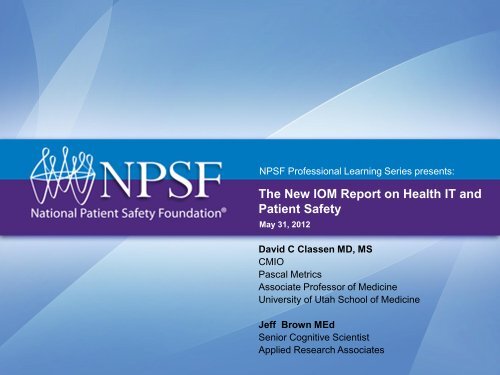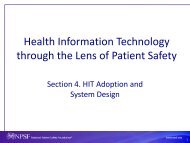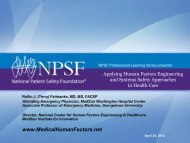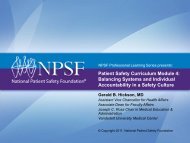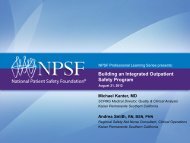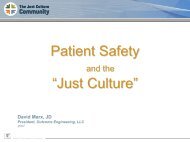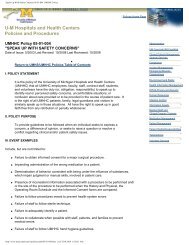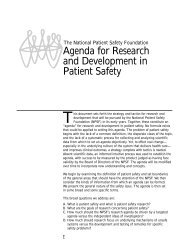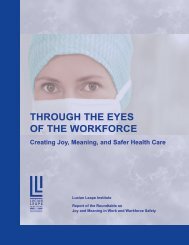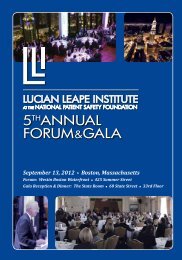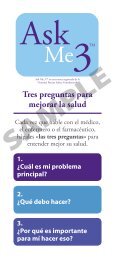Download slides of the presentation - National Patient Safety ...
Download slides of the presentation - National Patient Safety ...
Download slides of the presentation - National Patient Safety ...
You also want an ePaper? Increase the reach of your titles
YUMPU automatically turns print PDFs into web optimized ePapers that Google loves.
NPSF Pr<strong>of</strong>essional Learning Series presents:<br />
The New IOM Report on Health IT and<br />
<strong>Patient</strong> <strong>Safety</strong><br />
May 31, 2012<br />
David C Classen MD, MS<br />
CMIO<br />
Pascal Metrics<br />
Associate Pr<strong>of</strong>essor <strong>of</strong> Medicine<br />
University <strong>of</strong> Utah School <strong>of</strong> Medicine<br />
Jeff Brown MEd<br />
Senior Cognitive Scientist<br />
Applied Research Associates
Continuing Education*:<br />
This educational activity <strong>of</strong>fers 1.0 contact hours.<br />
Participant Notification<br />
Physicians<br />
The Doctors Company designates this educational activity for a maximum <strong>of</strong> 1.0 AMA PRA Category 1<br />
Credit(s) This webinar activity has been planned and implemented in accordance with <strong>the</strong> Essential<br />
Areas and policies <strong>of</strong> <strong>the</strong> Accreditation Council for Continuing Medical Education (ACCME) through <strong>the</strong><br />
joint sponsorship <strong>of</strong> The Doctors Company and <strong>the</strong> <strong>National</strong> <strong>Patient</strong> <strong>Safety</strong> Foundation (NPSF). The<br />
Doctors Company is accredited by <strong>the</strong> ACCME to provide continuing medical education for physicians.<br />
Pharmacy<br />
Inquisit ® is accredited by <strong>the</strong> Accreditation Council for Pharmacy Education as a provider <strong>of</strong><br />
continuing pharmacy education. This program will provide 1.0 ACPE Contact Hours under<br />
program number 232-999-12-086-L04-P.<br />
Nursing<br />
Inquisit is accredited as a provider <strong>of</strong> continuing nursing education by <strong>the</strong> American Nurses Credentialing<br />
Center’s COA. Inquisit is Iowa Board <strong>of</strong> Nursing provider 333 and 1.2 contact hours will be awarded for<br />
this program.<br />
*Continuing education credits are only available for live webcasts. A post-event survey must be completed<br />
within 7 days <strong>of</strong> participation to receive continuing education credits.<br />
2<br />
NPSF Pr<strong>of</strong>essional Learning Series<br />
May 31, 2012
Disclosure<br />
3<br />
NPSF Pr<strong>of</strong>essional Learning Series<br />
May 31, 2012
Learning Objectives<br />
• List major findings <strong>of</strong> <strong>the</strong> New IOM Report on HIT and<br />
<strong>Patient</strong> <strong>Safety</strong><br />
• Explain <strong>the</strong> implications <strong>of</strong> recommendations for vendors<br />
• State implications <strong>of</strong> recommendations for healthcare<br />
organizations<br />
• Name two approaches to proactive identification <strong>of</strong><br />
systemic conditions for patient harm<br />
4<br />
NPSF Pr<strong>of</strong>essional Learning Series<br />
May 31, 2012
NPSF Pr<strong>of</strong>essional Learning Series presents:<br />
The New IOM Report on Health IT and<br />
<strong>Patient</strong> <strong>Safety</strong><br />
May 31, 2012<br />
David C Classen MD, MS<br />
CMIO<br />
Pascal Metrics<br />
Associate Pr<strong>of</strong>essor <strong>of</strong> Medicine<br />
University <strong>of</strong> Utah School <strong>of</strong> Medicine<br />
Jeff Brown MEd<br />
Senior Cognitive Scientist<br />
Applied Research Associates
Health IT and <strong>Patient</strong> <strong>Safety</strong>:<br />
Building Safer Systems for Better Care<br />
May 31, 2012
Committee membership<br />
GAIL L. WARDEN (Chair)<br />
Henry Ford Health System<br />
JAMES P. BAGIAN<br />
University <strong>of</strong> Michigan<br />
RICHARD BARON*<br />
Greenhouse Internists, PC<br />
DAVID W. BATES<br />
Brigham and Women’s Hospital<br />
DEDRA CANTRELL<br />
Emory Healthcare<br />
DAVID C. CLASSEN<br />
University <strong>of</strong> Utah<br />
RICHARD I. COOK<br />
University <strong>of</strong> Chicago<br />
DON E. DETMER<br />
American College <strong>of</strong> Surgeons and<br />
University <strong>of</strong> Virginia School <strong>of</strong> Medicine<br />
MEGHAN DIERKS<br />
Harvard University and<br />
Beth Israel Deaconess Medical Center<br />
TERHILDA GARRIDO<br />
Kaiser Permanente<br />
ASHISH JHA<br />
Harvard University<br />
MICHAEL LESK<br />
Rutgers University<br />
ARTHUR A. LEVIN<br />
Center for Medical Consumers<br />
JOHN R. LUMPKIN<br />
Robert Wood Johnson Foundation<br />
VIMLA PATEL<br />
New York Academy <strong>of</strong> Medicine and<br />
Columbia University<br />
PHILIP SCHNEIDER<br />
University <strong>of</strong> Arizona<br />
CHRISTINE SINSKY<br />
Medical Associates Clinic and Health Plans<br />
PAUL C. TANG<br />
Palo Alto Medical Foundation and<br />
Stanford University<br />
*Resigned from committee March 2011<br />
7
Charge to <strong>the</strong> committee<br />
• Summarize existing knowledge <strong>of</strong> <strong>the</strong> effects <strong>of</strong> health IT<br />
on patient safety<br />
• Make recommendations to HHS regarding specific actions<br />
federal agencies should take to maximize <strong>the</strong> safety <strong>of</strong><br />
health IT–assisted care<br />
• Make recommendations concerning how private actors can<br />
promote <strong>the</strong> safety <strong>of</strong> health IT–assisted care, and how <strong>the</strong><br />
federal government can assist private actors in this regard<br />
8
Committee process<br />
• 12 month study<br />
• 3 in-person meetings<br />
• 2 public workshops<br />
• Data ga<strong>the</strong>ring from <strong>the</strong> public and vendors<br />
• Extensive literature review<br />
• 9 external reviewers<br />
9
Key findings<br />
• Health IT can improve patient safety in some areas such as<br />
medication safety; however, <strong>the</strong>re are significant gaps in <strong>the</strong><br />
literature regarding how health IT impacts patient safety<br />
overall<br />
• Safer implementation and use begins with viewing health IT<br />
as part <strong>of</strong> a larger sociotechnical system<br />
• All stakeholders need to work toge<strong>the</strong>r to improve patient<br />
safety<br />
10
Current state <strong>of</strong> health IT<br />
Magnitude <strong>of</strong> harm and impact <strong>of</strong> health IT on patient safety is<br />
not well known because:<br />
•Heterogeneous nature <strong>of</strong> health IT products<br />
•Diverse impact on different clinical environments and workflow<br />
•Legal barriers and vendor contracts<br />
•Inadequate and limited evidence in <strong>the</strong> literature<br />
11
The New Game: Harm Documentation<br />
Department <strong>of</strong> Health and<br />
Human Services<br />
OFFICE OF<br />
INSPECTOR GENERAL<br />
15,000 Medicare<br />
beneficiaries per<br />
month<br />
experience<br />
adverse events<br />
contributing to<br />
death<br />
State with <strong>Safety</strong><br />
Program Flat-line<br />
Improvement<br />
12<br />
NPSF Pr<strong>of</strong>essional Learning Series<br />
May 31, 2012
US Government Study<br />
13<br />
NPSF Pr<strong>of</strong>essional Learning Series<br />
May 31, 2012
Study Goal<br />
• Objectives<br />
o Capture incidence <strong>of</strong> patient harm<br />
o Assess preventability <strong>of</strong> adverse events<br />
o Estimate costs to Medicare<br />
• Congressional Mandates<br />
o Deficit Reduction Act <strong>of</strong> 2005 – “hospital-acquired conditions”<br />
o Tax Relief and Health Care Act <strong>of</strong> 2006<br />
14<br />
NPSF Pr<strong>of</strong>essional Learning Series<br />
May 31, 2012
Sample for <strong>National</strong> Incidence Study<br />
October<br />
2008<br />
999,645<br />
780<br />
• Sample month<br />
• Medicare beneficiaries<br />
discharged from acute<br />
care hospitals<br />
• Sample Medicare<br />
beneficiaries<br />
661<br />
• Hospitals represented<br />
15<br />
NPSF Pr<strong>of</strong>essional Learning Series<br />
May 31, 2012
Incidence Rates – <strong>of</strong> all beneficiaries<br />
13.5%<br />
• Adverse Events<br />
(NQF, HAC, F– I Level)<br />
0.6%<br />
• NQF Serious Reportable Events<br />
1.0%<br />
13.5%<br />
• Medicare Hospital-Acquired<br />
Conditions<br />
• Temporary Harm Events (E<br />
Level)<br />
16<br />
NPSF Pr<strong>of</strong>essional Learning Series<br />
May 31, 2012
Is safety improving in <strong>the</strong> US?<br />
Landrigan CP, Parry GJ, Bones CB, Hackbarth AD, Goldmann DA, Sharek PJ.<br />
Temporal trends in rates <strong>of</strong> patient harm resulting from medical care. New England<br />
Journal <strong>of</strong> Medicine. 2010 Nov; 363(22):2124-2134.<br />
17<br />
NPSF Pr<strong>of</strong>essional Learning Series<br />
May 31, 2012
Results-Demographics<br />
• Hospital descriptors<br />
▫ AHA size: 2 Small; 3 Medium; 5 Large<br />
▫ 8 Urban vs 2 Rural<br />
▫ 10 hospitals--3 Teaching vs 7 Non-teaching<br />
• 2341 patient records from 5 year period<br />
• 588 harms detected<br />
▫ 25 / 100 admissions<br />
18<br />
NPSF Pr<strong>of</strong>essional Learning Series<br />
May 31, 2012
Adverse Events by Category<br />
Harm Category<br />
Infectious<br />
Surgical/ Obstetrical<br />
Hematologic<br />
Renal/Fluids/Endocrine<br />
Respiratory<br />
Cardiovascular<br />
Gastrointestinal<br />
Neurologic<br />
O<strong>the</strong>r categories<br />
0 20 40 60 80 100 120<br />
Number <strong>of</strong> harms<br />
19<br />
NPSF Pr<strong>of</strong>essional Learning Series<br />
May 31, 2012
Trends in All Harms Over Time: External<br />
Slope: 0.98 (95% CI 0.93, 1.04 p = 0.47)<br />
Landrigan et al., New Engl J Med 2010; 363: 2124-34<br />
20<br />
NPSF Pr<strong>of</strong>essional Learning Series<br />
May 31, 2012
21<br />
NPSF Pr<strong>of</strong>essional Learning Series<br />
May 31, 2012
25<br />
NPSF Pr<strong>of</strong>essional Learning Series<br />
May 31, 2012
<strong>Safety</strong> as a system property<br />
• <strong>Safety</strong> is a characteristic <strong>of</strong> a sociotechnical system<br />
• System-level failures occur almost always because <strong>of</strong><br />
unforeseen combinations <strong>of</strong> component failures<br />
26
Features <strong>of</strong> safer health IT<br />
27
<strong>Patient</strong> engagement tools<br />
• Health IT can lead to safer care by<br />
– Enabling patients and families to participate in <strong>the</strong>ir<br />
care<br />
– Helping patients and families become more<br />
knowledgeable about conditions and treatments<br />
– Improving communication among health care<br />
providers, patients, and families<br />
– Facilitating shared decision making<br />
• However, patient use <strong>of</strong> health IT adds a layer <strong>of</strong><br />
complexity to <strong>the</strong> sociotechnical system<br />
28
29<br />
NPSF Pr<strong>of</strong>essional Learning Series<br />
May 31, 2012
Recommendations: Summary<br />
Current market forces are not adequately addressing <strong>the</strong><br />
potential risks associated with use <strong>of</strong> health IT<br />
All stakeholders must coordinate efforts to identify and<br />
understand patient safety risks associated with health IT by:<br />
•Facilitating <strong>the</strong> free flow <strong>of</strong> information<br />
•Creating a reporting and investigating system for health IT–<br />
related deaths, serious injuries, or unsafe conditions<br />
•Researching and developing standards and criteria for safe<br />
design, implementation, and use <strong>of</strong> health IT<br />
30
Recommendation 1<br />
The Secretary <strong>of</strong> Health and Human Services (HHS) should<br />
publish an action and surveillance plan within 12 months that<br />
includes a schedule for working with <strong>the</strong> private sector to<br />
assess <strong>the</strong> impact <strong>of</strong> health IT on patient safety and<br />
minimizing <strong>the</strong> risk <strong>of</strong> its implementation and use. The plan<br />
should specify:<br />
a. The Agency for Healthcare Research and Quality<br />
(AHRQ) and <strong>the</strong> <strong>National</strong> Library <strong>of</strong> Medicine (NLM)<br />
should expand <strong>the</strong>ir funding <strong>of</strong> research, training, and<br />
education <strong>of</strong> safe practices as appropriate, including<br />
measures specifically related to <strong>the</strong> design,<br />
implementation, usability, and safe use <strong>of</strong> health IT by all<br />
users, including patients.<br />
(continued on next slide)<br />
31
Recommendation 1 (continued)<br />
b. The Office <strong>of</strong> <strong>the</strong> <strong>National</strong> Coordinator for Health IT (ONC)<br />
should expand its funding <strong>of</strong> processes that promote safety<br />
that should be followed in <strong>the</strong> development <strong>of</strong> health IT<br />
products, including standardized testing procedures to be<br />
used by manufacturers and health care organizations to<br />
assess <strong>the</strong> safety <strong>of</strong> health IT products.<br />
c. ONC and AHRQ should work with health IT vendors and<br />
health care organizations to promote post-deployment safety<br />
testing <strong>of</strong> EHRs for high prevalence, high impact EHRrelated<br />
patient safety risks.<br />
d. Health care accrediting organizations should adopt<br />
criteria relating to EHR safety.<br />
e. AHRQ should fund <strong>the</strong> development <strong>of</strong> new methods for<br />
measuring <strong>the</strong> impact <strong>of</strong> health IT on safety using data<br />
from EHRs.<br />
32
One Focus Area: NQF Safe Practices<br />
Culture<br />
Consent and<br />
Disclosure<br />
Consent & Disclosure<br />
Workforce<br />
Information Transfer<br />
and Clear Communication<br />
Medication Management<br />
Healthcare-Associated<br />
Infections<br />
Condition- &<br />
Site-Specific Practices<br />
33<br />
NPSF Pr<strong>of</strong>essional Learning Series<br />
May 31, 2012
Information Transfer<br />
and Clear Communication<br />
34<br />
NPSF Pr<strong>of</strong>essional Learning Series<br />
May 31, 2012
-Excerpt-<br />
CPOE may be adopted<br />
with a stage approach<br />
once integrated information<br />
systems are in place to<br />
support safety and effective<br />
CPOE systems…<br />
The CPOE system is tested<br />
against The Leapfrog Group<br />
Inpatient CPOE Testing<br />
Standards…developed to<br />
provide organizations that are<br />
implementing CPOE with<br />
appropriate decision support<br />
about…<br />
35<br />
NPSF Pr<strong>of</strong>essional Learning Series<br />
May 31, 2012
36<br />
NPSF Pr<strong>of</strong>essional Learning Series<br />
May 31, 2012
37<br />
NPSF Pr<strong>of</strong>essional Learning Series<br />
May 31, 2012
38<br />
NPSF Pr<strong>of</strong>essional Learning Series<br />
May 31, 2012
39<br />
NPSF Pr<strong>of</strong>essional Learning Series<br />
May 31, 2012
40<br />
NPSF Pr<strong>of</strong>essional Learning Series<br />
May 31, 2012
41<br />
NPSF Pr<strong>of</strong>essional Learning Series<br />
May 31, 2012
42<br />
NPSF Pr<strong>of</strong>essional Learning Series<br />
May 31, 2012
43<br />
NPSF Pr<strong>of</strong>essional Learning Series<br />
May 31, 2012
44<br />
NPSF Pr<strong>of</strong>essional Learning Series<br />
May 31, 2012
45<br />
NPSF Pr<strong>of</strong>essional Learning Series<br />
May 31, 2012
46<br />
NPSF Pr<strong>of</strong>essional Learning Series<br />
May 31, 2012
47<br />
NPSF Pr<strong>of</strong>essional Learning Series<br />
May 31, 2012
Recommendation 2<br />
The Secretary <strong>of</strong> HHS should ensure ins<strong>of</strong>ar as possible that<br />
health IT vendors support <strong>the</strong> free exchange <strong>of</strong> information<br />
about health IT experiences and issues and not prohibit<br />
sharing <strong>of</strong> such information, including details (e.g.,<br />
screenshots) relating to patient safety.<br />
Recommendation 3<br />
ONC should work with <strong>the</strong> private and public sectors to make<br />
comparative user experiences across vendors publicly<br />
available.<br />
48
Recommendation 4<br />
The Secretary <strong>of</strong> HHS should fund a new Health IT <strong>Safety</strong><br />
Council to evaluate criteria for assessing and monitoring <strong>the</strong><br />
safe use <strong>of</strong> health IT and <strong>the</strong> use <strong>of</strong> health IT to enhance<br />
safety. This council should operate within an existing<br />
voluntary consensus standards organization.<br />
Recommendation 5<br />
All health IT vendors should be required to publicly register<br />
and list <strong>the</strong>ir products with ONC, initially beginning with EHRs<br />
certified for <strong>the</strong> meaningful use program.<br />
49
Recommendation 6<br />
The Secretary <strong>of</strong> HHS should specify <strong>the</strong> quality and risk<br />
management process requirements that health IT vendors<br />
must adopt, with a particular focus on human factors, safety<br />
culture, and usability.<br />
50
Recommendation 7<br />
The Secretary <strong>of</strong> HHS should establish a mechanism for both<br />
vendors and users to report health IT–related deaths, serious<br />
injuries, or unsafe conditions.<br />
a. Reporting <strong>of</strong> health IT–related adverse events should be<br />
mandatory for vendors.<br />
b. Reporting <strong>of</strong> health IT–related adverse events by users<br />
should be voluntary, confidential, and nonpunitive.<br />
c. Efforts to encourage reporting should be developed, such<br />
as removing <strong>the</strong> perceptual, cultural, contractual, legal, and<br />
logistical barriers to reporting.<br />
51
The <strong>Patient</strong> <strong>Safety</strong> and Quality Improvement<br />
Act <strong>of</strong> 2005<br />
▫ Creates “<strong>Patient</strong> <strong>Safety</strong> Organizations” (PSOs)<br />
▫ Establishes “Network <strong>of</strong> <strong>Patient</strong> <strong>Safety</strong> Databases”<br />
(NPSD)<br />
▫ Authorizes establishment <strong>of</strong> “Common Formats”<br />
for reporting patient safety events<br />
▫ Requires reporting <strong>of</strong> findings annually in AHRQ’s<br />
<strong>National</strong> Health Quality / Disparities Reports<br />
52<br />
NPSF Pr<strong>of</strong>essional Learning Series<br />
May 31, 2012
Recommendation 7-8<br />
53
Recommendation 8<br />
The Secretary <strong>of</strong> HHS should recommend that Congress<br />
establish an independent federal entity for investigating<br />
patient safety deaths, serious injuries, or potentially unsafe<br />
conditions associated with health IT. This entity should also<br />
monitor and analyze data and publicly report results <strong>of</strong> <strong>the</strong>se<br />
activities.<br />
54
55<br />
NPSF Pr<strong>of</strong>essional Learning Series<br />
May 31, 2012
56<br />
NPSF Pr<strong>of</strong>essional Learning Series<br />
May 31, 2012
Recommendation 9<br />
a. The Secretary <strong>of</strong> HHS should monitor and publicly report<br />
on <strong>the</strong> progress <strong>of</strong> health IT safety annually beginning in<br />
2012. If progress toward safety and reliability is not<br />
sufficient as determined by <strong>the</strong> Secretary, <strong>the</strong> Secretary<br />
should direct <strong>the</strong> FDA to exercise all available authority to<br />
regulate EHRs, health information exchanges, and PHRs.<br />
b. The Secretary should immediately direct <strong>the</strong> FDA to<br />
begin developing <strong>the</strong> necessary framework for regulation.<br />
Such a framework should be in place if and when <strong>the</strong><br />
Secretary decides <strong>the</strong> state <strong>of</strong> health IT safety requires<br />
FDA regulation as stipulated in Recommendation 9a<br />
above.<br />
57
Recommendation 10<br />
HHS, in collaboration with o<strong>the</strong>r research groups, should<br />
support cross-disciplinary research toward <strong>the</strong> use <strong>of</strong> health<br />
IT as part <strong>of</strong> a learning health care system. Products <strong>of</strong> this<br />
research should be used to inform <strong>the</strong> design, testing, and<br />
use <strong>of</strong> health IT. Specific areas <strong>of</strong> research include:<br />
a. User-centered design and human factors applied to health<br />
IT,<br />
b. Safe implementation and use <strong>of</strong> health IT by all users,<br />
c. Sociotechnical systems associated with health IT, and<br />
d. Impact <strong>of</strong> policy decisions on health IT use in clinical<br />
practice.<br />
58
Human Factors<br />
59<br />
NPSF Pr<strong>of</strong>essional Learning Series<br />
May 31, 2012
A Definition<br />
A multi-disciplinary/multi-specialty field<br />
<strong>of</strong> research and practice concerned with<br />
optimizing human-system performance,<br />
especially in high-risk, high-consequence<br />
settings and domains.<br />
60<br />
NPSF Pr<strong>of</strong>essional Learning Series<br />
May 31, 2012
It’s not about information<br />
technology, buttons or dials…<br />
61<br />
NPSF Pr<strong>of</strong>essional Learning Series<br />
May 31, 2012
62<br />
NPSF Pr<strong>of</strong>essional Learning Series<br />
May 31, 2012
63<br />
NPSF Pr<strong>of</strong>essional Learning Series<br />
May 31, 2012
64<br />
NPSF Pr<strong>of</strong>essional Learning Series<br />
May 31, 2012
65<br />
NPSF Pr<strong>of</strong>essional Learning Series<br />
May 31, 2012
66<br />
NPSF Pr<strong>of</strong>essional Learning Series<br />
May 31, 2012
Sociotechnical Systems<br />
67<br />
NPSF Pr<strong>of</strong>essional Learning Series<br />
May 31, 2012
“When technical systems have more variety than a<br />
single individual can comprehend, one <strong>of</strong> <strong>the</strong> few<br />
ways humans can match this variety is by<br />
networks and teams <strong>of</strong> divergent individuals…”<br />
Weick K., (2001). Making Sense <strong>of</strong> <strong>the</strong> Organization. Chapter 14, page 333.<br />
Blackwell Publisher, Ltd.<br />
68<br />
NPSF Pr<strong>of</strong>essional Learning Series<br />
May 31, 2012
Sociotechnical Systems Are<br />
Never ‘Out <strong>of</strong> <strong>the</strong> Woods’<br />
69<br />
NPSF Pr<strong>of</strong>essional Learning Series<br />
May 31, 2012
Declining D<br />
Revenue,<br />
Competition…<br />
Why did that happen?<br />
Loss <strong>of</strong> resilience.<br />
C<br />
New facility planned<br />
Cost cutting<br />
Focus on efficiency<br />
Normalized<br />
risk; unsafe<br />
behavior<br />
B<br />
Time pressure,<br />
> interruption,<br />
unworkable<br />
procedure,<br />
inadequate #<br />
scanners..<br />
Heightened<br />
A<br />
potential for an<br />
adverse event<br />
Clinical Space<br />
70<br />
NPSF Pr<strong>of</strong>essional Learning Series<br />
May 31, 2012
Issues <strong>of</strong> Context<br />
71<br />
NPSF Pr<strong>of</strong>essional Learning Series<br />
May 31, 2012
What’s <strong>the</strong> Pay<strong>of</strong>f?<br />
• Lesser risk <strong>of</strong> harm<br />
• Lesser risk <strong>of</strong> failed implementation<br />
• Information technology that supports ra<strong>the</strong>r<br />
than hinders <strong>the</strong> user<br />
72<br />
NPSF Pr<strong>of</strong>essional Learning Series<br />
May 31, 2012
• Health information technologies are an interactive element, among many, that toge<strong>the</strong>r<br />
shape <strong>the</strong> behavior <strong>of</strong> complex socio-technical systems.<br />
• We need clinically-situated research to understand cognitive<br />
requirements in advance <strong>of</strong> proposing ‘solutions’—how do <strong>the</strong><br />
elements <strong>of</strong> <strong>the</strong> cognitive system interact to affect and effect<br />
outcomes?<br />
• Implementation strategies should include robust processes for<br />
identifying workarounds—markers <strong>of</strong> an unintended impact on<br />
frontline clinical processes.<br />
• Healthcare organizations need persistent surveillance systems that<br />
are sensitive to side-effects <strong>of</strong> change in technologies, policies,<br />
processes, purchasing, tasks...<br />
• Usability science and user research are insufficient to understand <strong>the</strong><br />
requirements for information technologies in domains and pr<strong>of</strong>essions<br />
where <strong>the</strong>re is high consequence for failure.<br />
73<br />
NPSF Pr<strong>of</strong>essional Learning Series<br />
May 31, 2012
Mature Sciences can be<br />
applied towards Design<br />
Everyday<br />
Decisions<br />
• Usability Science<br />
• User Research<br />
Life or<br />
Death<br />
Decisions<br />
• Cognitive<br />
Systems<br />
Engineering<br />
methods<br />
74<br />
NPSF Pr<strong>of</strong>essional Learning Series<br />
May 31, 2012
Submit A Question<br />
75<br />
NPSF Pr<strong>of</strong>essional Learning Series<br />
May 31, 2012


